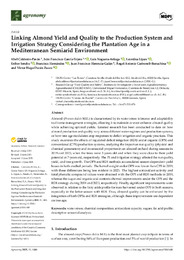Título :
Linking almond yield and quality to the production system and irrigation strategy considering the plantation Age in a mediterranean semiarid environment |
Autor :
Calderón Pavón, Abel
García-Tejero, Iván Francisco
Noguera-Artiaga, Luis
Lipan, Leontina
Sendra, Esther
DURAN ZUAZO, VICTOR HUGO 
Herencia-Galán, Juan Francisco
Carbonell-Barrachina, Ángel Antonio
Durán Zuazo, Víctor Hugo |
Editor :
MDPI |
Departamento:
Departamentos de la UMH::Producción Vegetal y Microbiología |
Fecha de publicación:
2025-05 |
URI :
https://hdl.handle.net/11000/37066 |
Resumen :
Almond (Prunus dulcis Mill.) is characterized by its water stress tolerance and adaptability
to diverse management strategies, allowing it to maintain or even enhance almond quality
while achieving optimal yields. Limited research has been conducted to date on how
almond production and quality vary across different water regimes and production systems,
or how tree age modulates crop responses to deficit irrigation and organic practices. This
study examines the effects of regulated deficit irrigation (RDI) under organic (OPS) and
conventional (CPS) production systems, analyzing the impact on nut quality (physical and
chemical parameters) and its sensorial properties in an almond orchard during seasons in
2019 and 2023, when the trees were 3-years old and when they were close to their yield
potential at 7-years old, respectively. The PS and irrigation strategy affected the nut quality,
yield, and tree growth. The OPS and RDI methods accumulated season-dependent yield
losses in both studied periods. The kernel weight under OPS was lower than CPS in 2019,
with these differences being less evident in 2023. The highest antioxidant activity and
total phenolic compound values were obtained with the OPS and RDI methods in 2019,
whereas the sugar and organic acid contents showed improvements under the OPS and the
RDI strategy during 2019 and 2023, respectively. Finally, significant improvements were
observed in relation to the fatty acids profile for nuts harvested under OPS in both seasons,
especially in the latter season with RDI. Thus, almond quality can be enhanced by the
integration of both OPSs and RDI strategies, although these improvements are dependent
on tree age
|
Palabras clave/Materias:
water stress
chemical composition
antioxidant capacity
sugars
fat acid profile
descriptive sensorial analysis |
Área de conocimiento :
CDU: Ciencias aplicadas: Ingeniería, tecnología e industria química. Metalurgia:/ Alimentos y nutrición. Enología. Aceites. Grasas |
Tipo de documento :
info:eu-repo/semantics/article |
Derechos de acceso:
info:eu-repo/semantics/openAccess |
DOI :
https://doi.org/10.3390/agronomy15061448 |
Publicado en:
Agronomy 2025, 15(6), 1448 |
Aparece en las colecciones:
Artículos - Producción vegetal y microbiología
|
 La licencia se describe como: Atribución-NonComercial-NoDerivada 4.0 Internacional.
La licencia se describe como: Atribución-NonComercial-NoDerivada 4.0 Internacional.
.png)
